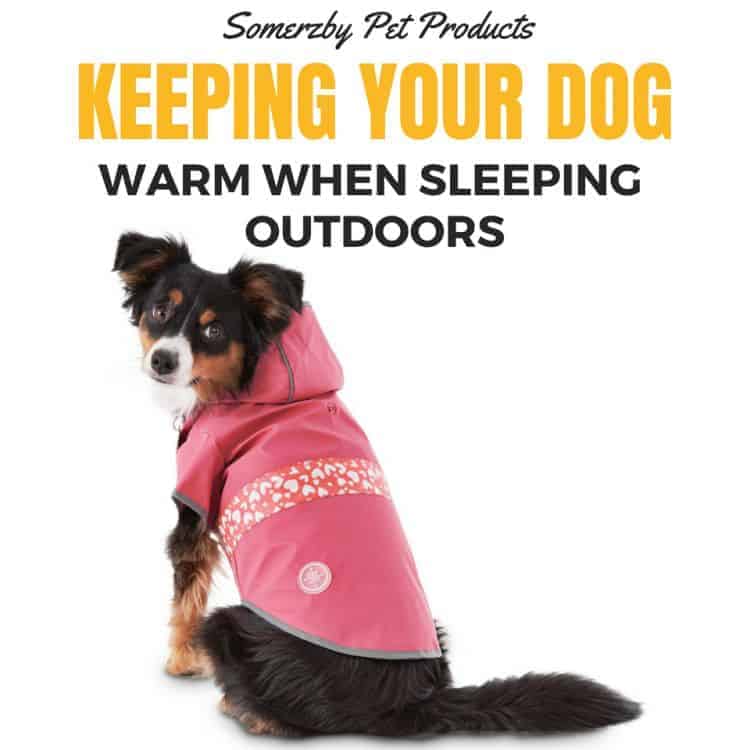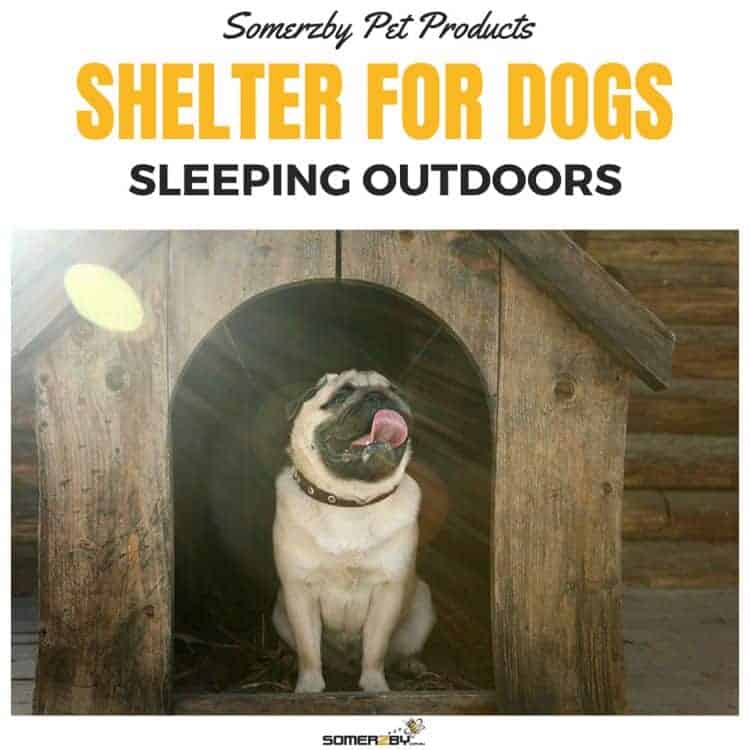Dogs
Should My Dog Sleep Indoors or Outdoors, and Is It Cruel To Keep Him Outdoors?
Everyone has an opinion on the classic debate – should pet dogs sleep inside or outside?
Whilst it is becoming more and more popular for dogs to sleep inside, deciding where your dog sleeps is a personal decision.
When determining where your dog will sleep, there are multiple factors to consider including where you live and the breed of your dog.
The number one concern for most dog owners is the weather.
Can Dogs Sleep Outside in the Cold?
Many owners worry about their dog getting too cold when sleeping outside. Most dogs can withstand cooler conditions than humans.
Dogs use their coat, skin and fat to protect them against the cold. However, dogs are still susceptible to risks associated with cold temperatures.
It is the responsibility of the pet owner to provide shelter and make sure your dog is both healthy and comfortable.
It is worth noting that more dogs are injured or die from extreme hot weather, than extreme cold.
Location
When deciding if you are going to have your dog sleep outside in the winter weather, consider how cold it really gets where you live.
Australia has a range of different climates. Whilst it is warm most of the year in the Northern Territory, it can get very chilly in Tasmania.
When the temperature drops to 10 degrees Celsius, it is starting to be too cold for some dogs. Seven degrees Celsius is possibly dangerous for some breeds.
When the temperate drops to 4 degrees Celsius and below, it can be life threatening for most dogs.
As well as temperature, consider the wind-chill. It is important to think about how cold it really feels.

What Type of Dogs Can Sleep Outside in the Cold?
Whilst any dog will suffer if left outside in freezing weather, some dogs are much hardier and suited to outside than others.
Dogs which are young puppies, very old or sick are not as capable of regulating their body temperature. Dogs with arthritis might find it is worsened in the cold, with cold weather causing stiffness.
Some breeds are not suited to sleeping outside.
This includes breeds with short hair or thin coats. Small toy breeds with thin or small bodies (with low body fat) are also not suited to cold weather. This includes greyhounds, chihuahuas and beagles.
Larger breeds with thick, double-layered coats will be the most tolerant to the cold. This includes huskies, newfoundlands and samoyeds.
If you are unsure if your dog’s breed can handle the cold, ask your vet.
Recognising if Your Dog is Too Cold
It is important to recognise when your dog is too cold as it can put your dog at risk. Use your pet’s behaviour to guide your judgement.
Signs of your dog being at risk from the cold include shivering, being curled up in a ball, whining or expressing anxiety.
When in doubt, use common sense. Watch your dog and follow your instincts on how it is feeling.
Risks of Dogs Sleeping Outside in the Cold
The most common risk of your dog sleeping outside is feeling cold and therefore discomfort.
However, in very cold areas dogs can be susceptible to hypothermia, which occurs when a dog’s body temperature drops too low.
Mild to moderate symptoms include weakness, a lack of alertness and muscle stiffness. Severe symptoms include difficulty breathing, coma and death.
Frostbite is also possible in chilly areas, especially where snow is present. Symptoms include discoloration of the area, pain when touched and swelling.

How to Keep Your Dog Warm When Sleeping Outside
If your dog is sleeping outside, it may be necessary to make extra precautions to keep it warm.
If your dog is small or has a thin coat, it may be wise to get it a jacket. This is especially important overnight. Make sure your dog’s coat fits well so that it does not rub, get caught or slip off.
When grooming your dog in winter, consider leaving its coat a bit longer. Taking off too much hair can mean your dog might not be able to hold as much warmth.
If you live somewhere with snow, ensure you don’t use a metal water bowl as your dog’s tongue can stick. Check regularly to make sure water isn’t frozen.
If the temperature has dropped significantly, your dog may need to increase the number of calories in its diet. Dogs need energy for normal activities plus extra energy to create warmth. Beware over feeding!

Shelters for Dogs Sleeping Outside
If your dog is sleeping outside, it is essential it has a good quality kennel to allow it to hide away from the weather.
A kennel should shelter your dog from harsh wind, rain and the cold.
Dogs require this protection so that heat is not drawn away from their body. The kennel must be sturdy and durable.
It should be constructed from water- and wind-proof materials. The kennel should not leak in the rain and protect your dog from draughts. The roof must slope away from the entrance.
Somerzby Dog Kennels have asphalt rooves which are waterproof and will protect your dog from rain. They feature plastic flaps hanging over the entrance which reduce cold winter draughts.
Your dogs kennel should also be raised off the ground to prevent the dog feeling the cold ground. The Somerzby XL Double Dog Kennel has plastic adjustable feet to give a raised floor and natural insulation.
It is important to make sure the kennel is always dry.
Add some warm and soft layers to the kennel floor to help keep your dog warm and comfortable. Use Vet Bed, blankets or a soft cushion. Regularly check the bedding is clean and dry.
Somerzby Dog Kennels have an optional bed which can be added. Somerzby dog beds feature a luxurious fleece sleep surface and ultra-plush bolsters to keep your pet warm and cosy. They feature synthetic fleece and cosy polyester filling with plastic backing.
Sources:
- https://goo.gl/ricjrQ
- https://www.petmd.com/dog/care/how-cold-too-cold-dog
- http://www.vetico.com.au/blog/is-it-cruel-to-make-your-dog-sleep-outside-in-winter-584
- https://www.leospetcare.com/when-is-it-too-cold-outside-for-my-dog-or-cat/
- http://www.pethealthnetwork.com/dog-health/dog-checkups-preventive-care/cold-weather-tips-dogs





My neighbours recently purchased a new puppy that is left outside all day and night. I have been doing some research to give to the owners about why dogs should not be left outside and I came across your blog. I am astonished that the majority of the information on the internet provides little to no information on the psychological impacts of leaving a dog outside. It doesnt matter what breed the dog is, all dogs love company and have a need for safety and security. Dogs can be very anxious creatures because they are constantly on the look out for threats or trying to make sense of our human world. If a dog is left outside, specially overnight, it wont have the opportunity to fully relax and “have a good night sleep”. Leaving dogs outside for prolong periods of time and specially overnight can result in behavioural issues in the future. There is fantastic research by Dr Gregory Berns on dogs’ brains and how we all share the same brain structure/functions. I am trying to get the message out there that as pet owners we need to be more mindful and respectful of our dog’s emotional and physical care needs and not just “what is my dog doing for me”.
I call BS. Some dogs prefer to be outside and many dogs do not need to have constant human attention.
If the dog is not too small and has a thick coat, it will do just fine outdoors almost anywhere in the US in a decent dog house. In many cases it is just as ridiculous to make a dog sleep indoors. Where they sleep and what they do is a matter of training and discipline and who is the leader of the pack, you or your pooch. So it is your choice.
We raised sheep in Wyoming when I was young and our collies slept outdoors with the sheep all summer and all winter. Coyotes and a rare cougar might want a little woolly snack. They might take on one dog but not 3 or 4 .
The temperatures often reach 20 or 30 below zero. The dogs would “dog pile” together or burrow into snow where the temperature is warmer or roll up in an old rug. They like to sleep under a wagon or other shelter out of the precipitation. But they can survive the most brutal blizzards.
In Alaska I would image many sled dogs sleep outdoors in the arctic winter. I don’t think they are in the igloos with their Eskimo owners very often. One of my college roommates had a young, mischievous, black Newfoundland dog. He would find some thin ice to break, roll in the water, then roll in the snow. He became the abdominal white snow dog. He could easily hide about anywhere on the snow and jump on unsuspecting members of the family. One would have to be crazy to let that dog in the house for even a few minutes, let alone all night.
Here is a site that describes how to properly house a dog outside in rule happy Minneapolis MN, where the state motto is: “You can’t do that.”
https://www.coonrapidsmn.gov/DocumentCenter/View/4312/Proper-Outdoor-Shelter-for-Dogs-PDF
Sheepdogs are a bit different .They might be a little hardier . With thicker coats in winter and bury themselves in snow or pack together .But below 10 degrees celsius for puppies and dogs with thin coats is inhumane and damn cruel noncaring …………..it can easily make them susceptible to pneumonia and chest infections and its just inhumane unless there is a lined kennel and the dog wears a dog jacket and its windproof . Dogs get frost bite . They feel just likewe do . They are feel creatures who will suffer greatly if exposed . So …protect them .
I have a german shepherd dog and she have 7 puppies and they outside day and night and right now it cold. What should I do. They are 4 months old. And I worry about them slot when they outside . I look after them everyday
Hey Anita, although matured healthy dogs that have medium to long fur such as German Shepherds can easily sleep outside if they prefer it, small puppies cannot regulate their core temperatures and not only need to be in a place that has a constant temperature that does not fluctuate but somewhere where they can relax and not get anxious. So I would recommend if you can possibly move them indoors or anyplace that is safe and accessible.